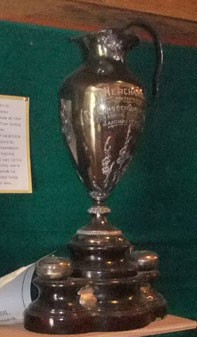
The MAS office will be closed for Christmas Holidays December 24th to January 4th.
Usual office hours will resume on January 5th, 2026
As a continuation of our conservation series, we will be finishing off the final few Agents of Deterioration as defined by the Canadian Conservation Institute (CCI) in Ottawa. If you want to learn more about CCI, see their website or our April 29th blog post.
Pollutants! Who would have thought that pollutants effect museum collections? What are considered to be pollutants?
The category of pollutants covers much more than one would think! CCI says that pollutants are compounds that have a chemical reaction with your object; these pollutants can be present in the form of gases, liquids, solids, or aerosols. AND they have negative impacts upon your museum objects.
There are three ways in which these pollutants can reach your objects:
1. Airborne
2. Transferred at a point of contact
3. Intrinsic
​Airborne pollutants are present in the atmosphere and/or created through humans and their activities; basically, just living our lives creates pollutants for museum objects. With so many airborne pollutants that could harm our objects, CCI has thankfully narrowed down the list of key airborne pollutants to work against:

I won’t go into detail about each individual pollutant listed here (I could talk all day!), I just want to make you aware of them. For specific information about each, go to the CCI Agents of Deterioration webpage dedicated to Pollutants. What I do want is the recognition that these airborne pollutants exist and are something that can be controlled and prevented from damaging your collections. I see many of these pollutants effecting the collections in our province. Once you know that these pollutants play a part in the condition of your collections, you can then take specific actions to prevent further deterioration. CCI has many recommendations on their webpage for you, such as using sorbent materials (acid free tissue) or housing your objects with the proper temperature and relative humidity. There is also a great table in that article about different control strategies depending on your ability. Check it out!
Notice that the trophy above is tarnished, this is a result of airborne pollutants.
Pollutants transferred at a point of contact will usually result in staining or discolouration. There are a variety of sources for this type of pollutant, including: unsealed woods, acidic paper or cardboard, flexible Polyvinyl Chloride (PVC), sulfur-based plastics, soft polyurethane foam, most tapes, liquid adhesives, salt contaminated surfaces, metals under humid conditions, oily materials, and fatty acids from humans (one of the reasons do not touch plays a role here!).
There are also several prescribed strategies in avoiding this type of pollution; such as not using rubber bands, letting coatings dry for several weeks before placing objects on, and avoiding the use of metal fasteners.
Intrinsic pollutants are those that are already within the object you are trying to preserve. Don’t be bummed out by this prospect, there are ways to avert disaster! Objects that have intrinsic pollutants include cellulose acetate film and paper artworks. Often the best course of action for objects that seem like they are their own worst enemy is to keep them cool and dry. The presence of incorrect temperature and/or relative humidity (as well as light) can speed up chemical processes and lead to the degradation of the object that you are trying to preserve! CCI says that it also important to identify these intrinsically bad objects to ensure that they do not affect other objects through points of contact or through the air.
This topic is definately a big one. If you have any questions feel free to contact us at the Museums Association or read the original text off the CCI website.

Usual office hours will resume on January 5th, 2026

Just a reminder that the Final Report for the Museum Improvement Micro Grant for Community Museums is due December 5th! Your final report will require you to provide a brief

Thursday October 16, 202512:00pm CSTOnline via Zoom: https://us02web.zoom.us/j/86760471705?pwd=XjoSlWAP0TJZVYrprylmLqujOkVrk2.1 No registration required. The Museum Grant Program (MGP) provides operational funding to help foster strong, vibrant, community-based Saskatchewan museums that are valued